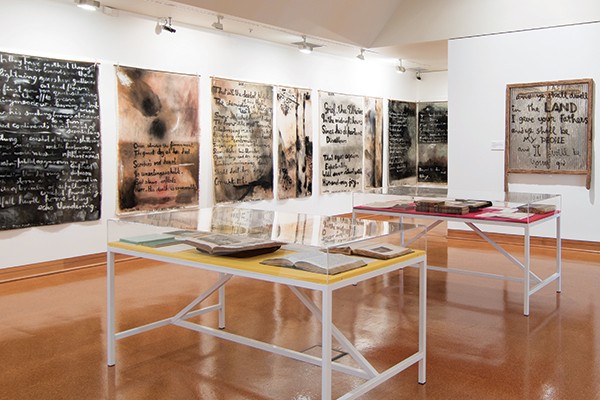Above image: Freefall, exhibition installation view, featuring Colin McCahon, The Wake, 1958; Ralph Hotere, And ye shall dwell in the land I gave your fathers and ye shall be my people and I will be your God. Ezekiel, 36. 28, 1983, image reproduction by permission of the Hotere Foundation Trust. Courtesy of Hocken Collections - Te Uare Taoka o Hākena, University of Otago. Photo: Iain Frengley.
For a tiny country floating near the bottom of the world, New Zealand has managed to produce an impressive array of skilled painters and excellent writers. In Dunedin we frequently see these creative folk celebrated through art exhibitions and our City of Literature status. Yet something appreciated less frequently is the two worlds in parallel: art and writing as different sides of the same coin.
The Hocken Collection’s current exhibition Freefall tackles this concept head-on. A stunning collection of art, books, maps and items are brought together, from not only the Hocken itself but also the Dunedin Public Art Gallery and Special Collections. The relationship between writers and artists, poets and painters is the key focus of the exhibition; echoes of text are present throughout the visual works on display. Wonderfully varied and unexpected, Freefall provides a web of connections between individuals, their work, and the time period in which they were creating.
The work which seems to best encapsulate this idea is The Wake (1958) by Colin McCahon. Its sixteen hanging, unstretched canvases provide a backdrop to the rest of the exhibition, but this work is by no means a wallflower. The Wake is magnificent and turbulent, foreboding and filled with a sense of tangible energy. McCahon’s fierce brushstrokes collide with the poetry of John Caselberg, a New Zealand writer who frequently collaborated with McCahon in the 20th century.
Every item included in this exhibition seems to have a story to tell, both individually and in conversation with the other works on display. 16th century religious art contrasts splendidly with McCahon’s modern alternatives — bold iconography transposed onto the New Zealand landscape in a move at once shocking and unfamiliar. Bill Manhire’s Malady poem is adopted into the large, black paintings of Ralph Hotere, while Hotere’s drawings for a Hone Tuwhare poetry collection hang framed in a row. The curiosities are endless — leaves used as postcards, complete with stamps (an old Stewart Island tradition, I am told), alongside an 1882 edition of Sir Walter Buller’s controversial native bird survey book and a poster for the “Mutant Hillbilly” 1990 Otago O’Week.
One of the difficulties when curating a show as varied and busy as Freefall is preventing the space from feeling like an overloaded, I Spy picture book. But somehow Robyn Notman has pulled it off. Freefall feels calm rather than crammed, a captivating experience that continuously provokes new ideas and considerations. A winner for lovers of art, literature, history, culture, and the myriad of subjects in between.



